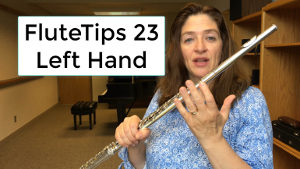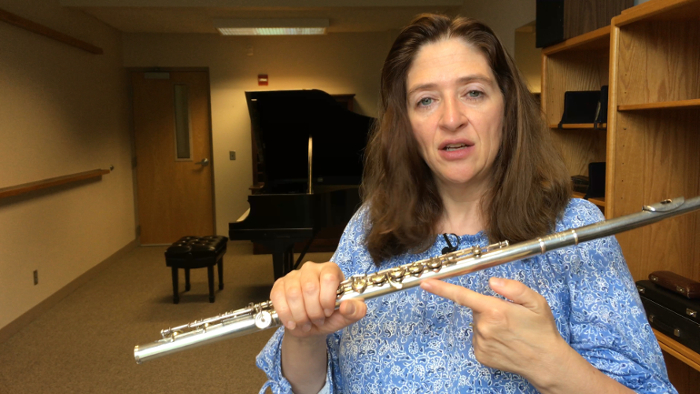Let’s talk about a couple of little issues with the left hand. First let’s clarify an aspect of the flute that will affect your left hand position [it’s not open/closed hole]:
In-line G
Offset G
Half Offset G
I don’t believe that open/closed hole makes a difference on how your left hand is positioned. But having an in-line G, offset G, or half offset G will make a difference. I have an inline G and the way I was taught was to have a bent wrist that allows my fingers to cover the holes and have a nice curve. When looking at it from the side, it looks like the hand is almost straight or perpendicular to the flute. And my wrist is severely bent – my teacher said to make it almost straight up and down. With my in-line G, this position works great. I’ve never had wrist problems and my fingers are relaxed and on the keys.
If you have an off-set G your wrist will look different. The main idea (whether you have and inline G, an off-set G, or a half off-set G) is to make sure that the pad of your finger is covering the keys. Keep the pad in the middle of the key with your pinky fully on the Ab key and let your wrist fall where it may. Too many students come to me with their wrist almost straight. This means that the barest amount of finger is touching the keys to close them. Sometimes the Ab pinky is hanging about in the air! Of course, if you have the open hole, that wouldn’t cover it at all. When these students purchase an open hole flute they struggle to learn how to keep their fingers in the necessary positions. I think today’s ideas are that for better wrist health, you don’t want to bend it quite this much. Hence the off-set is G gaining popularity.
The Ab pinky is a wayward finger. It is often hanging below the key or up in mid-air above the key. In these cases it’s too slow to react when called into action. The finger needs to be sitting on top of the key, not just barely hanging on the edge. So, let it have the whole key, and keep it there while playing.
The thumb.
There might be a bit of controversy about thumb positioning but here’s what I teach and what I do – so far it’s done well for me. The thumb needs to be played straight up and down almost on the side. I play with it like this, and I can still roll back and forth between B and the B flat keys. The reason why you want to play with it on the side is that it’s actually quite natural.
Take a look at your general hand shape when it is very relaxed. Look at the relationship to the first finger. Then apply that shape and angle to the flute. Then place your hand on the flute properly without the thumb on. Whatever the natural look of your thumb – don’t change it. Just place it on the key. Don’t bend it, don’t twist it. Just place it. I would have to actually bend my hand in a weird position if I wanted to play with the flat part of my thumb – the way that many students do. When their thumb goes on, they bend it and play with the tip. That can be very hard on your hand and it is not efficient. The idea is to keep your thumb in the most comfortable, most natural position to move back and forth from B to Bb. Try this and see how comfortable and natural it feels.
Try that out. Use a mirror. Look at your hand. See what it’s doing and make sure that how you’re playing is comfortable. If something causes you pain, then you need to change something. Find a teacher who can help find the problem. As long as the fingers are covering and you keep your fingers low when you’re playing so that you can lift up and put them back down and they don’t fly high, your’re golden (or solid silver, in my case).
Try that out, use a mirror, and let me know how it feels.
Have Fun!
DoctorFlute
Watch me demonstrate this: FluteTips 23 Left Hand

More on your hand positions:
